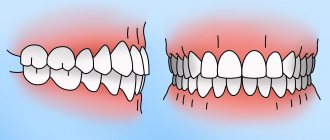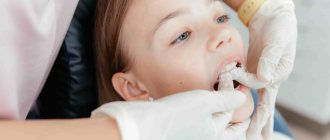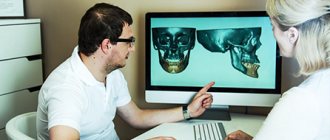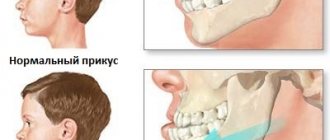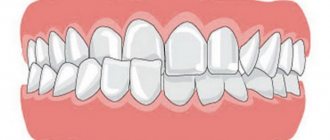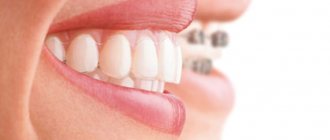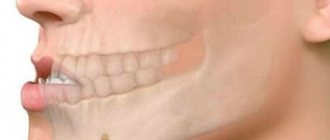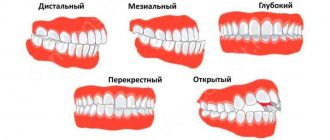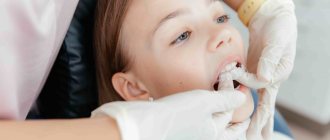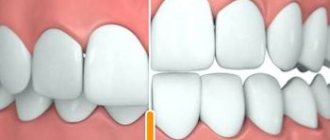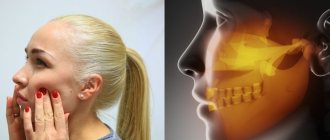In this regard, the results of a recent sociological survey we conducted are of some relevance.
I will be happy to share the data with you. A study of the population's opinion on the need for orthodontic treatment was carried out on the basis of a generalization of data obtained during a survey of patients upon treatment. So.
100 patients (aged 6 to 18 years) or their parents were interviewed.
As it turned out, the reason for visiting the dentist was:
1. Referral from a pediatrician - 42%
:
2. The same number of patients applied on the initiative of their parents - 42%
:
3. Bad tooth - 9%
:
4. Disease of the mucous membrane
membranes of the oral cavity -
3%
:
Considering the growing need of children for orthodontic care, attention is drawn to the fact that of the respondents, the largest number of patients turned to an orthodontist:
- on their own initiative - 62%;
- was referred by a pediatric dentist - 30%,
- referred by a speech therapist -5%.
Unfortunately, these figures indicate that doctors of related specialties do not always pay attention to the presence of dental anomalies in a child.
Orthodontic tooth movement in childhood can be compared to a chess game
. This analogy is valid in many ways.
Let's play with our imagination a little
The game of chess is played with 32 ivory pieces, positioned symmetrically with respect to the center line and divided into two equal parts that are in opposition to each other. Do they look like our teeth? Yes!
The debut of a game is a critical factor in determining its future strategy. Whether the game is won or lost depends on the strategy of moving individual pieces, i.e. ultimately the outcome of the game depends on her opening. Do they look like our teeth? Without a doubt!
William J. Clark , known to most orthodontic specialists.
.
In orthodontics, the analogue of a chessboard is the facial skeleton, which plays a fundamental role, since the main “chess pieces” - our teeth - are located on it. And if you play a chess game with mistakes since childhood, then a new piece may appear on the chessboard - a dental implant
:
But this is already “adult chess” - dental implantation
, and we are not talking about it today.
Correction of bite in children
What is special about children? The fact is that children are a growing group of patients. Growing patients have high growth potential. What does this mean? The fact that we can influence the growth of one or another segment of the jaw, we can influence the change in bite most effectively, while in adults, since growth has already been completed, we can only actually work with that bite, with that position of the teeth, which is available. Therefore, the prognosis for children is much more favorable, on the one hand. In this material, we will first look at correcting the bite in young children, and at the end we will talk about modern possibilities for correcting the bite in older children, 15-18 years old.
Mouthguards
The most accessible and effective method of correcting a bite is wearing a mouthguard. They are also made individually, but based on an impression of the patient’s teeth and from high-quality polymer. The trays are transparent, so they are difficult to see on the teeth.
Over the entire period of treatment, it will be necessary to change several trays, since the corrector will have to correspond to the changes occurring in the teeth.
Duration of treatment is 1 year or more. They do not cause discomfort or side effects, so many patients prefer aligners, which have a more affordable price compared to aligners.
What methods exist for straightening teeth and correcting bites in children?
The first method of straightening teeth in children is the “classic of the genre”, something that was known back in the Soviet Union - these are plates.
What are the advantages of records (there are four of them):
- is that records are relatively cheap to make,
- the fact that children can easily brush their teeth (again, due to the fact that they are removable).
- the third advantage is that there are quite powerful mechanics for correcting the bite, because most often special screws are installed in the plates, which are unscrewed by the parents, that is, which are activated and create the force necessary either to move the teeth or to expand the size of the jaws.
- well, and another fourth plus is that they are produced quite quickly, that is, you don’t have to wait long for them - literally a few days, and the record is ready.
What are the disadvantages of records? There are also four of them:
- The first disadvantage of the plates
is that the plates are quite uncomfortable. The plate is quite bulky - accordingly, the space for the tongue is reduced. It is constantly observed that children play with records: they remove them with their tongues, play around, and so on. Therefore, they are quite inconvenient. - Second minus .
Serious. The records change the perception of taste. This is especially true for the plate on the upper jaw. The fact is that there are taste buds on the hard palate, the plate covers them, and the child, in theory, when undergoing a course of bite correction should walk with the plate constantly, removing it only to brush his teeth. It turns out that when a child eats, the food does not touch the palate, and therefore the sensation of taste changes. It's not very pleasant. - The next, third disadvantage
(I have already partially mentioned this) is that diction is impaired with records due to the fact that they are simply in the space for the tongue. Children adapt quite quickly to records in terms of diction, but still there are definitely residual phenomena, and if, say, we have a schoolchild in front of us, then this creates a lot of inconvenience, for example, from the point of view of sound pronunciation in foreign languages - where teachers are constantly fighting for pure sound pronunciation, for correct diction, and so on. In this regard, the plates are, of course, very inconvenient, and the temptation to take them off during classes and then forget to put them on is very great. - The fourth minus
. And this is also the next minus for parents and doctors, and a plus for children (this is such a plus or minus) - the ability to remove these plates! Yes, this is convenient for hygiene, but from another point of view, children are often guilty of this - when they leave parental control (for example, to school), they take off the records and put them, God willing, in some other box ( or even in your pocket), they walk around all day without the records, everything is fine, and then they put them on again in front of their parents. It turns out that the effectiveness of treatment in correcting a child’s bite in this case is reduced to zero.
Summary of records
So what can I say based on the records? If the child is disciplined, if he wears the plate well, constantly and follows all the doctor’s recommendations, then this is a very good technology, and it can solve certain problems quite quickly. The downside - from all that I have listed - is that if the child is undisciplined or, say, there is low cooperation with him, then in this case the plates are more of a torment than any kind of effectiveness.
Questions and answers about records
- But there is also a moment that even if the child does not wear it partially, it is twisted, expanded, and the parent can notice that it does not go over the teeth if you start to expand it.
- Absolutely right.
- Then see a doctor.
It turns out that there is still some impact on the child in this situation. - No.
You see, the fact is that if the child does not wear the plate, then the jaw does not expand properly, as intended in the plate. That is, in this case the plate dangles, as patients sometimes say, it’s like a galosh. It no longer puts pressure on the teeth and does not fit. And in this case, of course, the doctor, for his part, tries to somehow correct it, screw it back, but often this leads to the fact that the plate has to be redone. And these are new investments, we are stalling in one place, and the problem is not being solved. Therefore, the effectiveness of the plate, if you wear it, is high, but, unfortunately, there are a lot of such “victims” who did not wear the plate, and then they come at an older age.
When can you straighten your teeth without braces?
Dental growth disorder in dentistry also has the term “malocclusion”, since it is the pathological location or other deviations that cause the incorrect position of the jaws.
It is necessary to solve the problem of malocclusion, even if it is not very pronounced, in childhood. If left untreated, many problems may arise in adult life (impaired diction, problems with chewing food, frequent dental diseases, etc.).
Teeth straightening without braces in adolescents is permissible for the following indications:
- gaps between two teeth or several units;
- curvature of 1–2 teeth;
- displacement of the position of 1–2 teeth relative to the entire row;
- crooked tooth;
- different heights of teeth;
- contraindications to wearing braces.
If the violations are serious, then it is unlikely to be possible without braces. But in case of minor deviations, or with timely intervention, it is possible to carry out therapy to straighten the teeth with braces. the admissibility of such alternative treatment is assessed by the orthodontist.
The second option for correcting malocclusion in children is elastopositioners.
Elastic positioners are a whole group of aligners. They are devices made of silicone. In appearance, they resemble boxing splints that athletes wear.
– Are these so-called myofunctional trainers?
– Yes, that’s absolutely right. You see, a trainer is more of a “proper name”, that is, a certain company has such devices that are called “trainers”. They can, of course, be called trainers, but it seems to me that it would be better to call them “elastic positioners”. That is, this is more of a collective name. What's the point? The fact is that these devices are made in an ideal bite, in the correct bite. Some of them have cells for the correct position of the teeth, that is, they work as guides. Some do not have these cells. But the point is that the elastopositioner, when worn by a child, trains the muscles to put the lower jaw in the correct position. As you know, our upper jaw is fixedly welded to the skull, it is impossible to move it, that is, the lower jaw, in fact, is responsible for the bite, how it relates to the upper jaw. And the position of the lower jaw is often determined by the condition of the muscles, because it is suspended by the muscles. And thus, elastopositioners work with muscles, they train the muscles to put the lower jaw in the correct position. The wearing mode is as follows for elastopositioners, the main recommendations are: two hours during the day and be sure to sleep in the trainer. So what are the advantages of elastopositioners?
There are four advantages of myofunctional trainers:
- The first advantage
is that the child is undergoing orthodontic treatment, no one knows, that is, this is a hidden orthodontic treatment. When treated with trainers, there are no problems with eating: to have a full meal, you just need to remove them. That is, neither taste buds nor the volume of the oral cavity are affected here, everything is normal. - The second plus
is that they are hygienic, that is, like the plates, they can be removed, the child can easily carry out oral hygiene, and nothing interferes with us. - The third advantage
is that they are relatively cheap and can be obtained fairly quickly, since they are purchased from dealer companies. - The fourth advantage
is that, due to the fact that they are made of silicone, elastopositioners are bioinert. Nowadays, the degree of allergy in the population is quite high, so, for example, in order to put a plate on a child, if we have a child with allergies, we often cannot do this, because the plastic still produces some residual monomers, which can contribute to an increase in the allergic background . Silicone is absolutely bioinert, so we can prescribe it to allergy sufferers, children with reduced immunity, and so on. This is their advantage.
What are the disadvantages of elastopositioners? There are two disadvantages:
- The first disadvantage
is that, again, since this is a removable device, you can either put it on or not. And this requires very high cooperation, both on the part of the child himself and on the part of the parents, because I personally always tell parents at my appointments: “It’s your job to stand over the child and force them to put on these mouth guards, to control how the child wears them.” and constantly remind him: put on the mouth guard, put on the mouth guard.” - The second disadvantage
is that, unlike plates, elastopositioners develop less force, so if, say, a child has a narrow jaw, then on the plate we can expand it much faster due to the fact that there are screws there. There are no screws here, here we simply select a larger device in a certain way so that it presses and expands the jaw.
The third
method of correcting the position of teeth in children, the next group of devices is
Operating principle of the devices
Trainers are worn on the teeth for several hours a day and at night. The duration of wearing is determined by the doctor, based on the severity of the specific clinical case. The devices have a mechanical effect on the teeth (as if moving them into the correct position) and train the facial muscles. Thanks to this, trainers simultaneously perform several functions:
- align the vector of tooth growth;
- correct the relationship between the upper and lower jaws;
- train facial muscles;
- widen the jaws to create enough space for teeth to grow;
- eliminate bad multifunctional habits by teaching the child to breathe through the nose, press the tongue to the palate, and not suck a finger or other objects.
Functional devices for correcting malocclusion in children
Their meaning lies in the fact that they do not have a source of mechanical force (like, say, braces or plates), and here the main effect is achieved through the action of the child’s muscles.
What are the advantages of functional devices? Three advantages:
- First plus
. Again, due to the fact that they eat without them, they do not disrupt food intake and do not impose any restrictions. - Second plus
. Again, they do not make oral hygiene difficult; the child can do this absolutely calmly. - Third plus
. Well, they are quite effective. But the effectiveness here is questionable, because everything depends on the mode in which the child wears this device. If he wears it, the effect develops quite quickly; if not, then it is clear that there is no effect either.
What are the disadvantages of functional devices? There are two disadvantages, but they are significant:
- The first disadvantage
is that most functional devices are very bulky. They consist of a metal frame of a very sophisticated design and plastic parts. Therefore, they also take up a lot of space in the mouth and are quite inconvenient. - Well, the second disadvantage
is that, unlike, say, an elastopositioner, they need to be worn for the maximum number of hours per day. That is, the child must wear them both at school and at home, which, of course, also does not bring much pleasure and often provokes a refusal of these devices.
The fourth way
to correct dental occlusion in children is braces, oddly enough.
Until what age can teeth be straightened with a plate?
Until what age do plates be placed on teeth is a question to be decided on an individual basis. Some devices work best during the period of active changes in occlusion, so they are recommended to be worn until 10-11 years of age. Other products perform well until the teeth completely change - up to 12-14 years. But the doctor assesses the situation more fully.
Often, orthodontists use a combined treatment method - changing devices, selecting new ones for the current situation. That is why it is not always necessary to delve into the names of plates for straightening teeth. The result is important, not what the dental plates are called.
It is difficult to answer how long a plate is worn on the teeth. Some patients require full-time braces and additional treatment with braces at age 14. For others, the situation improves in 1-2 years.
During an orthodontic consultation at Aza&Buka, patients will receive complete information about the treatment. The doctor will not just show a photo of an orthodontic children’s dental plate, but will also conduct an initial diagnosis, tell you the features of the planned correction, the approximate duration of treatment, and prospects. While the adults are talking, children can get acquainted with the variety of orthodontic devices - choose the color of the plate for the teeth and the design.
There is a so-called 2x4 braces system
The idea is that the child is given braces on four permanent incisors (these are the front teeth) and two large molars. That is, it turns out that we can only use this system in children, starting from the age of seven or eight, when the incisors have already erupted.
What are the advantages of braces in young children when correcting their bite?
- The first advantage
is that with such a system (2x4) the effect occurs quite quickly, because it uses the mechanics and power of braces, which, in fact, move the teeth. - The second advantage
is that the braces are not removable, and therefore the child simply does not have the opportunity to take them off, say, during a visit to school, and put them back on. But this is also a minus of braces. About this - below
The global problem and disadvantage that lies in braces is that they are non-removable, which means that:
- firstly
, they contribute to the accumulation of plaque, and children do not always have the opportunity to brush their teeth properly, especially in school settings. This causes some discomfort. - secondly
, braces also impose restrictions on the intake of hard foods. That is, food must be crushed. Either chop it into pieces, or it should have a soft consistency. - and thirdly
, of course, this is what I already said, difficulties in oral hygiene, which means that the risk of developing caries, gum inflammation and everything that we consider as complications from improper oral hygiene increases.
If we consider all these devices in terms of the speed of occurrence and development of the effect, then, of course, the last technique - braces
- is the most effective. Again, I repeat, because it uses the power of the mechanics of the brace system.
Prevention of malocclusion
Preventive measures begin almost immediately after the birth of the child. Experts recommend following a number of recommendations:
- Gently massage lips and cheeks;
- use orthopedic attachments that form the correct bite;
- introduce solid foods into the diet in a timely manner;
- When baby teeth appear, gradually wean off the pacifier;
- monitor the baby during sleep, not allowing him to suck his fingers;
- correctly apply the baby to the bottle or breast.
If a young mother does not have the proper experience and does not know how to properly attach a baby to the breast, then she needs to consult with a local pediatrician. A visit to the pediatric dentist is a must to minimize the risk of developing facial or dental pathologies. Children aged 4 years and older should be taught to brush their teeth on their own.
Timely prevention will help minimize the risk of complications. As a child gets older, his diction deteriorates, which can cause problems communicating with peers and lead to depression. Aesthetic defects are easiest to correct at an early age.
Now about correcting the bite in children of senior school age
Correcting the bite in children without braces is a youth trend
Justin Bieber trusted only aligners to straighten his teeth:
Benefits of correcting your bite without braces
- Unlike braces, aligners do not injure the oral mucosa. The edge of the tray undergoes special treatment and does not damage the gums
- The patient can remove the mouth guard while eating, and therefore there are no dietary restrictions as during treatment with braces
- Mouth guards can be removed while brushing teeth, which means the patient will not need special devices for oral hygiene
- Even the most aesthetic vestibular braces are more noticeable than clear aligners.
- The cost of treatment with invisible (relatively of course) lingual braces is often exorbitant, which cannot be said about aligners
- You can read a comparative analysis of treatment between braces and aligners in this article
Correction of bite with aligners due to diastema
Diastema can generally be corrected perfectly without braces. The aligners cope with the task 100%. In this example, treatment of the diastema took 5 months
.
Correction of bite with aligners during reverse incisal overlap
In this case, the treatment was more serious; teeth were straightened on both jaws. The duration of treatment is 15 months
.
Correcting a bite without braces using the example of spaces between teeth in the lower jaw
Teeth correction with aligners was carried out exclusively on the lower jaw and took 6 months
.
Correcting a bite with aligners using the example of turning the front teeth
Without using the lower jaw, aligners were worn only on the upper jaw. The total treatment period is 14 months.
Issues of correcting bites in adults are a separate topic that also requires detailed analysis. Read about it in the next article. Orthodontist, Ph.D. Tatyana Gevorkyan
Types of violations
Dentists distinguish the following types of malocclusion:
- distal – the upper part protrudes forward;
- mesial – the lower jaw protrudes forward;
- deep – the upper teeth overlap the lower teeth excessively;
- open – there is no closure of the front teeth while the back teeth are closed;
- cross – the lower teeth overlap the upper teeth partially or completely.
Additionally, excessive crowding or sparseness of teeth and disorders affecting individual elements (turns, tilts, various displacements relative to the axis) are also distinguished. There are often conditions in which a combination of several problems occurs simultaneously.
Record care
For full treatment, you need to wear the plates constantly, removing them only during meals and before bed. In order for the structure to last as long as possible, it should be properly cared for.
· Before the next fixation, the plate should be washed under running water.
· Clean the structure in the morning and evening with soft toothbrushes, using special gels or regular toothpaste.
· Once a week, the record should be soaked overnight in cleaning concentrate, and if necessary, use deep cleaning products.
It is advisable that parents supervise the process of wearing and caring for dental plates. If used irregularly, the treatment process may be prolonged and its effectiveness may decrease. In addition, with poor oral hygiene or errors in the care of the structure, additional dental problems may arise, for example, the development of caries, plaque deposits and tartar formation.
Indications for installation of orthodontic plates
The main indications for the installation of orthodontic plates for children are:
· adjusting the distance between teeth and eliminating gaps (diastemas and threes) between them;
· change in the width of the sky;
· acceleration or deceleration of jaw growth, as well as correction of its shape (for example, eliminating narrowness);
· displacement of incorrectly located teeth and their fixation in the right place;
· preventing further curvature (crowding) of the dentition;
· correction of the bite and prevention of relapses of its violation.
